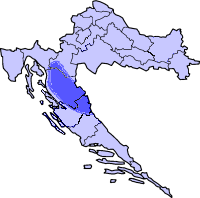
Guduscani
Encyclopedia

Gacka
Gacka is a river located in the Lika region in central Croatia. Because for a large part of its course it is a subterranean river, estimates on its length vary. The overground part has undergone substantial human intervention - before it was 32 kilometers long, now it is only 11 km...
(Lika
Lika
Lika is a mountainous region in central Croatia, roughly bound by the Velebit mountain from the southwest and the Plješevica mountain from the northeast. On the north-west end Lika is bounded by Ogulin-Plaški basin, and on the south-east by the Malovan pass...
), between upper Kupa river
Kupa (river)
The Kupa or Kolpa river forms a natural border between north-west Croatia and southeast Slovenia.The Kupa originates in Croatia in the mountainous region of Gorski kotar, northeast of Rijeka, in the area of Risnjak National Park...
and the Dalmatian coast
Dalmatia
Dalmatia is a historical region on the eastern coast of the Adriatic Sea. It stretches from the island of Rab in the northwest to the Bay of Kotor in the southeast. The hinterland, the Dalmatian Zagora, ranges from fifty kilometers in width in the north to just a few kilometers in the south....
. It has been assumed, that they were part of the Vandals
Vandals
The Vandals were an East Germanic tribe that entered the late Roman Empire during the 5th century. The Vandals under king Genseric entered Africa in 429 and by 439 established a kingdom which included the Roman Africa province, besides the islands of Sicily, Corsica, Sardinia and the Balearics....
, Goths
Goths
The Goths were an East Germanic tribe of Scandinavian origin whose two branches, the Visigoths and the Ostrogoths, played an important role in the fall of the Roman Empire and the emergence of Medieval Europe....
or Lombards
Lombards
The Lombards , also referred to as Longobards, were a Germanic tribe of Scandinavian origin, who from 568 to 774 ruled a Kingdom in Italy...
.
In the Frankish Annals, the Guduscani are mentioned as allies to the Carolingians, the Duke Borna
Borna
Borna is a town in the Free State of Saxony, Germany, capital of the Leipzig district. It is situated approx. 30 km southeast of Leipzig. It has approx. 21,000 inhabitants.-History:Borna as a town is more than 750 years old....
is mentioned as "dux Dalmaciae", "dux Dalmatiae et Liburniae" and "dux Guduscanorum". Borna had conquered the Guduscani, who were an independent tribe.
In 818 they were part of an envoy of Borna
Borna of Croatia
Borna was the Knez of Littoral Croatia in 803–821 under the Frankish Empire. He was the son of his predecessor, Višeslav.- Ruler of Dalmatia :...
sent with the South Slavic tribe
South Slavs
The South Slavs are the southern branch of the Slavic peoples and speak South Slavic languages. Geographically, the South Slavs are native to the Balkan peninsula, the southern Pannonian Plain and the eastern Alps...
of Timočani
Timocani
The Timočani or Timochani were a medieval South Slavic tribe that lived in the territory of present-day eastern Serbia, west of the Timok River, as well as in the regions of Banat, Syrmia and west Moesia....
to the court of Louis the Pious
Louis the Pious
Louis the Pious , also called the Fair, and the Debonaire, was the King of Aquitaine from 781. He was also King of the Franks and co-Emperor with his father, Charlemagne, from 813...
in Herstal
Herstal
Herstal, formerly known as Heristal, or Héristal, is a municipality of Belgium. It lies in the country's Walloon Region and Province of Liege along the Meuse river. Herstal is included in the "Greater Liège" agglomeration, which counts about 600,000 inhabitants...
.
In 819 Ljudevit Posavski
Ljudevit Posavski
Ljudevit Posavski was a Croatian Duke of Pannonian Croatia from 810 to 823. The capital of his realm was in Sisak. As the ruler of the Pannonian Slavs, he led an unsuccessful resistance to Frankish domination. He held close ties with the Carantanian and Carniolan tribes and with the Serbian tribe...
conquered their lands and pushed Borna to Vinodol.
They were part of the army of Borna
Borna of Croatia
Borna was the Knez of Littoral Croatia in 803–821 under the Frankish Empire. He was the son of his predecessor, Višeslav.- Ruler of Dalmatia :...
against Ljudevit Posavski
Ljudevit Posavski
Ljudevit Posavski was a Croatian Duke of Pannonian Croatia from 810 to 823. The capital of his realm was in Sisak. As the ruler of the Pannonian Slavs, he led an unsuccessful resistance to Frankish domination. He held close ties with the Carantanian and Carniolan tribes and with the Serbian tribe...
at the Battle of Kupa
Battle of Kupa
The Battle of Kupa occurred at Kupa River in 819. It involved the Guduscans of Lika, led by Prince Borna of Croatia against Prince Ludevitus of County between Drava and Sava, who was Borna's nephew.-Battle:...
but deserted before the battle. Borna conquered their lands again upon returning from the battle.
The Guduscani were later described by Constantine VII
Constantine VII
Constantine VII Porphyrogennetos or Porphyrogenitus, "the Purple-born" was the fourth Emperor of the Macedonian dynasty of the Byzantine Empire, reigning from 913 to 959...
(905-959), who mentioned them as part of a state of White Croatia
White Croatia
White Croatia is a vaguely defined area, said to lie somewhere in Central Europe, near Bavaria, beyond Hungary on south of Poland and west of Ukraine, and adjacent to the Frankish Empire from which the part of White Croats crossed the Carpathians and migrated in the 7th century into Dalmatia...
, its capitol Krakow including parts of Bohemia, Slovakia and land of later Poland.
Sources
- Danijel Dzino, Becoming Slav, Becoming Croat: Identity Transformations in Post-Roman and Early Medieval Dalmatia, p. 182-186, 200-201 . ISBN 9004186468, 9789004186460
- Bernhard Walter Scholz, Carolingian chronicles: Royal Frankish annals and Nithard's Histories, p. 104-106

